How To Repair Water Damaged Iphone
Taking the right first steps can be the difference between life and death for an iPhone with liquid damage. Unfortunately, there's a lot of misinformation online about what really works when it comes to rescuing a liquid-damaged iPhone.
In this article, we'll explain what causes iPhone water damage and show you how to check for it. We'll talk about common symptoms of water damage, what to do immediately after dropping an iPhone in water, and how to decide whether to fix a water-damaged iPhone or buy a new one.
If you just dropped your iPhone in water and you need immediate help, skip down to the Emergency section to learn what to do when an iPhone is exposed to liquid.
Liquid Damage Happens When You Least Expect It
During my time at the Genius Bar, I learned that liquid damage doesn't only occur when iPhones get dropped in toilets and pools. It happens at the gym, playing golf, or on a hike. iPhone water damage can happen anywhere. A single drop can wreak havoc inside an iPhone.
Every iPhone since the 7 has been advertised as water-resistant, but this shouldn't be confused with being waterproof. We'll get more into IP ratings and the difference between waterproof and water-resistant later in this article.
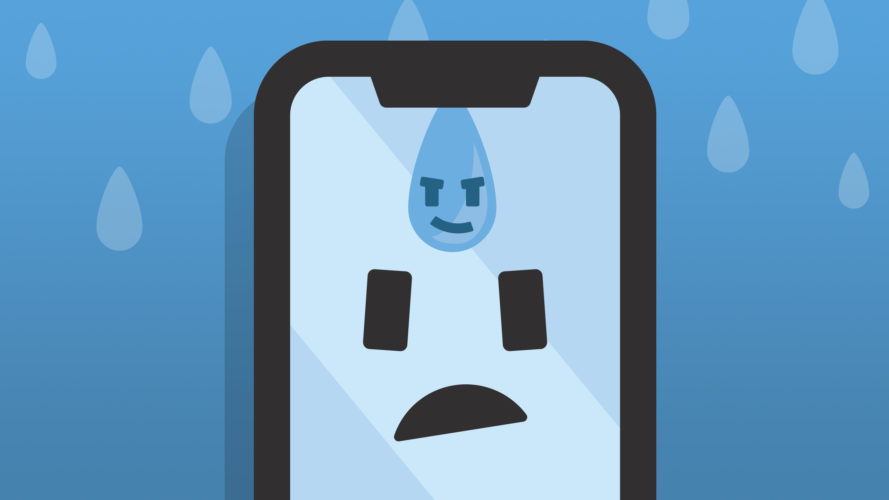
In short (there will be puns), liquid damage occurs when water or another liquid comes into contact with an iPhone's water-sensitive electronics. Although newer iPhones are less susceptible to water damage than older models, a tiny drop of liquid is all it takes to damage an iPhone beyond repair.
The water-resistant seal on newer iPhones is just as susceptible to wear and tear as the rest of the phone. It's designed to resist water, but not the wide array of liquids, lotions, and gels that many of us use every day.
What Does iPhone Water Damage Look Like?
Liquid damage can be obvious or invisible. Sometimes it appears as tiny bubbles under the screen or corrosion and discoloration inside its charging port. However, iPhone water damage usually doesn't look like anything — at least from the outside.
How To Check For iPhone Water Damage
The best way to check for iPhone water damage is to look at its liquid contact indicator, or LCI. On newer iPhones, the LCI is located in the same slot as the SIM card. On older models of the iPhone (4s and earlier), you'll find LCIs in the headphone jack, charging port, or both.
Here's where you'll find the liquid contact indicator on every iPhone:
| Model | LCI Location |
|---|---|
| iPhone 12 Pro / 12 Pro Max | SIM Card Slot |
| iPhone 12 / 12 Mini | SIM Card Slot |
| iPhone 11 Pro / 11 Pro Max | SIM Card Slot |
| iPhone 11 | SIM Card Slot |
| iPhone SE 2 | SIM Card Slot |
| iPhone XS / XS Max | SIM Card Slot |
| iPhone XR | SIM Card Slot |
| iPhone X | SIM Card Slot |
| iPhone 8 / 8 Plus | SIM Card Slot |
| iPhone 7 / 7 Plus | SIM Card Slot |
| iPhone 6s / 6s Plus | SIM Card Slot |
| iPhone 6 / 6 Plus | SIM Card Slot |
| iPhone 5s / 5c | SIM Card Slot |
| iPhone SE | SIM Card Slot |
| iPhone 5 | SIM Card Slot |
| iPhone 4s | Headphone Jack & Charging Port |
| iPhone 4 | Headphone Jack & Charging Port |
| iPhone 3GS | Headphone Jack & Charging Port |
| iPhone 3G | Headphone Jack & Charging Port |
| iPhone | Headphone Jack |
How To Check The LCI Inside The SIM Card Slot
To check the LCI on a newer iPhone, use a paperclip to pop out the SIM tray, which is located below the side button (the power button) on the right side of your iPhone. Stick the paper clip inside the tiny hole. You may need to press down with some force to eject the SIM tray.
Note: It's important to make sure the outside of your iPhone is completely dry before you remove the SIM tray. If you just dropped your iPhone in liquid and it's still wet, skip down to our section on what to do first if your iPhone gets dropped in water.
Next, remove the SIM tray and SIM card, and hold your iPhone with the screen facing down. From this angle, use a flashlight to look into the SIM card slot and check the LCI. As we'll discuss later, it's better to leave a wet iPhone face down on a flat surface than face up.
How To Check An LCI Inside The Headphone Jack Or Charging Port
It's easier to see the LCIs on older iPhones. Shine a flashlight into your iPhone's headphone jack or charging port, depending on which model you have.
What Does An LCI Look Like?
The size and shape of an iPhone's LCI varies from model to model, but it's usually pretty to tell if the LCI has been "tripped", as we used to say at the Genius Bar. Look for a small line or dot just inside the edge of the SIM card slot, at the bottom of the headphone jack, or in the middle of the dock connector (charging port) on older iPhones.
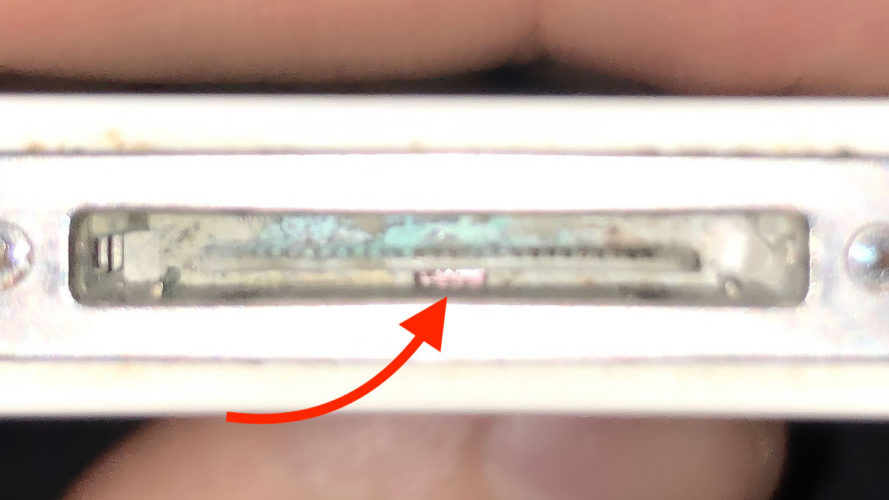
What Happens If My LCI Is Red?
A red LCI indicates that your iPhone has come into contact with liquid, and unfortunately, that means you'll have to pay. You'll pay less if you have AppleCare+ or carrier insurance than if you have no coverage at all.
We'll get into prices and how to decide whether to repair or replace a water damaged iPhone below. But don't lose hope. Just because an LCI is read doesn't mean an iPhone won't come back to life.
What Should I Do If The LCI Is Pink?
Unfortunately, pink is just a lighter shade of red. Whether the LCI is light red or dark red, your iPhone has some sort of liquid damage and won't be covered under warranty.
What Should I Do If The LCI Is Yellow?
Although it doesn't happen very often, don't be surprised if your LCI appears yellow. The good news is that yellow isn't red, which means your iPhone hasn't been damaged by liquid.
Some other substance (gunk, dirt, lint, etc.) may have discolored your iPhone's LCI. We recommend trying to clean out the SIM card slot, headphone jack, or charging port using an anti-static brush or brand new toothbrush.
If the LCI remains yellow, it wouldn't hurt to take your iPhone into the Apple Store! However, if nothing is wrong with your iPhone, there isn't much for an Apple tech to do.
Will My iPhone Be Covered Under Warranty If Its LCI Is Still White?
If the LCI is white or silver, the issue your iPhone is experiencing may not be liquid-related. If you dropped your iPhone in the pool before it stopped working, it probably is. The good news is that if Apple can't prove your iPhone was liquid damaged, your warranty might still be valid.
However, just because a LCI isn't red doesn't mean that Apple will cover the iPhone under warranty. If there is any evidence of liquid or corrosion inside an iPhone, Apple techs may deny warranty coverage — even if the LCI is still white.
Don't Get Any Funny Ideas…
A lot of people see a red LCI and panic. Some people try to use whiteout to cover the LCI, and others remove it with a pair of tweezers. Don't do it! There are two good reasons not to try to cheat:
- There's a good chance you'll cause more damage to your iPhone by tampering with the LCI.
- Apple techs see LCIs all day, every day. It's very easy to tell if an LCI is missing. If an LCI has been tampered with, the iPhone goes from out-of-warranty to voided warranty status. A new phone at full retail price costs hundreds of dollars more than an out-of-warranty replacement at the Genius Bar.
What's The Difference Between "Out Of Warranty" and a "Voided Warranty"?
If you take a water-damaged iPhone to an Apple Store, you'll probably be told it's "out of warranty." You'll pay a lot less to replace your iPhone if you have AppleCare+, but even if you don't, replacing an out of warranty iPhone is a lot cheaper than buying a new one.
If your iPhone warranty has been "voided", that's bad. An iPhone with a voided warranty has been disowned by Apple. They won't repair it at the Genius Bar. Your only option will be to buy a new iPhone at full retail price.
Generally speaking, the only way to void your iPhone's warranty is to tamper with it. If you remove the LCI, it voids the warranty. If you take it apart and lose a screw, it voids the warranty.
But even if you accidentally smash it, drop it in a lake, or run it over with your car (I've seen all of these), you weren't doing something you weren't supposed to be doing. (At least, according to Apple.) In those cases, you'll pay for an "out of warranty" replacement or repair.
Symptoms Of iPhone Water Damage
Water damage can cause a variety of problems on an iPhone. Once liquid gets inside, it's difficult to know where it will spread or what type of damage it will cause. Below, we've listed several of the most common symptoms of iPhone water damage.
If Your iPhone Is Getting Hot
Water-damaged lithium-ion batteries can get very, very hot. Although it's incredibly rare (especially for iPhones), lithium ion batteries can catch on fire when they're damaged. Every Apple Store has a fire safe in the Genius Room. I never had to use it, but be very careful if you feel your iPhone starting to heat up much hotter than normal.
If There's No Sound On Your iPhone
When water seeps into an iPhone and causes damage, its speakers could malfunction and disrupt its ability to play sounds. This could affect your ability to listen to music, hear the ringer when someone calls, or make calls of your own using the speakerphone.
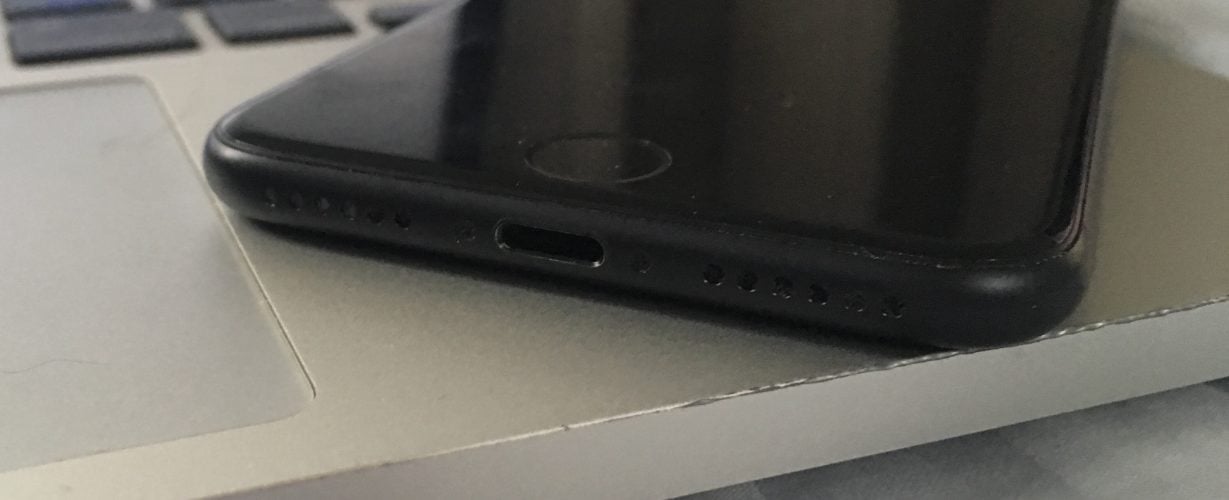
As water begins to evaporate from inside your iPhone, its speakers may come back to life. If they sound staticy or garbled at first, the sound quality may improve over time — or it may not.
We can't be certain it will help, but the newest Apple Watches use their built-in speakers to expel water after being submerged. Could this work for an iPhone? We're not sure, but if the speaker is making any sound at all, it can't hurt to bump up the volume and try.
If Your iPhone Isn't Charging
One of the most common and most frustrating iPhone problems happens when it won't charge. If water gets into your iPhone's Lightning port (the charging port), it can cause corrosion and prevent your iPhone from being able to charge at all.
Try charging your iPhone with multiple cables and multiple chargers before coming to this conclusion. However, if the LCI is red and your iPhone isn't charging, liquid damage is likely the cause.
If you tried to use rice to dry out your iPhone before reading this article (which we don't recommend), take a flashlight and look inside the charging port. On several occasions, I found a grain of rice stuck inside. Don't try to jam a Lightning cable inside the lightning port if it's not going in easily. Instead, use a toothbrush you've never used before to gently brush out debris.
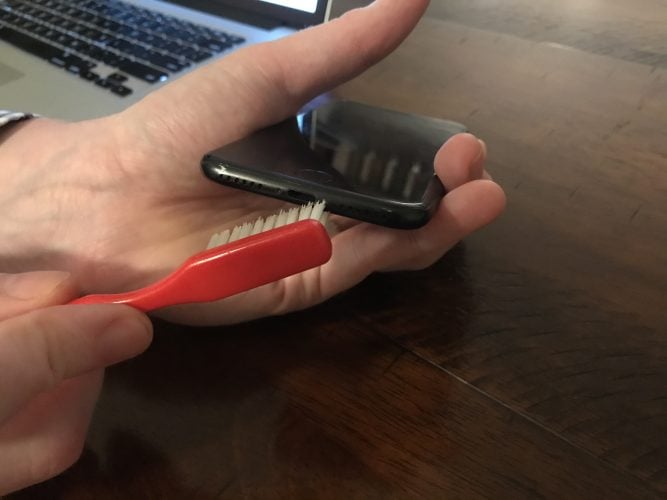
When it was impossible to remove the rice without damaging the electronics, a phone that may have come back to life had to be replaced. A friend who had this problem actually borrowed tools sculpting tools from a friend to remove the grain of rice, and it worked! We don't recommend using anything metal, however, except as a last resort.
If Your iPhone Isn't Recognizing The SIM Card
The SIM card is what stores the data on your iPhone that helps you carrier tell it apart from the other phones on its network. Information like the authorization keys of your iPhone are saved on the SIM card. These keys allow your iPhone to access the minutes, messages, and data of your cell phone plan.
Your iPhone might not be able to connect to your carrier's cellular network if liquid has damaged the SIM card or SIM card tray. One sign that your SIM card or SIM tray has been damaged by liquid contact is if it says "No SIM" in the upper left-hand corner of your iPhone's display.
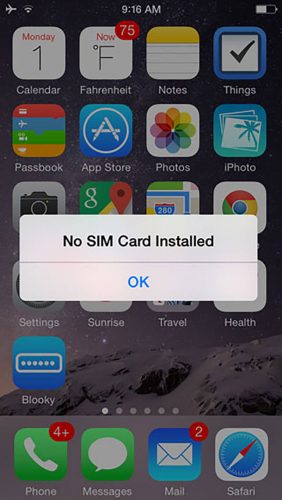
If you can rule out the possibility of a software or carrier-related problem causing your iPhone to say No SIM, you may need to have its SIM card or SIM card tray replaced.
If Your iPhone Has No Service
When water damage affects an iPhone's antenna, it will either have no service or very poor service. Either way, an iPhone isn't an iPhone if you can't make phone calls. Our article can help you fix issues with poor or no service on iPhone.
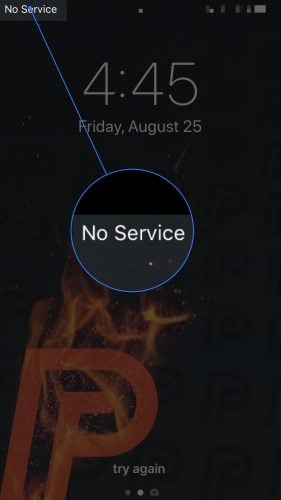
If The Apple Logo Is Flashing On Your iPhone
One sign that your iPhone has significant water damage is if it's stuck flashing on the Apple logo. When it happens, it's possible your iPhone is stuck in a restart loop.
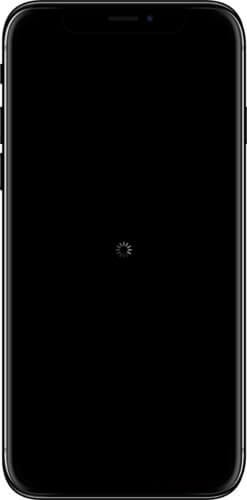
Try hard resetting your iPhone to see if you can fix the problem. Here's how to hard reset your iPhone, depending on which model you have:
How To Hard Reset An iPhone 6s and Earlier Models
Simultaneously press and hold the Home button and the power button until the screen goes black and the Apple logo appears. You can release both buttons when you see the Apple logo on the display of your iPhone.
How To Hard Reset An iPhone 7
Press and hold the volume down button and the power button at the same time until the Apple logos appears on the screen of your iPhone. Release both buttons as soon as the Apple logo appears.
How To Hard Reset An iPhone 8 and Newer Models
Quickly press and release the volume up button, then quickly press and release the volume down button, then press and hold the side button until the Apple logo appears on the display. You may have to hold the buttons on your iPhone for 25–30 seconds, so be patient and don't give up too soon!
If The Apple Logo Is Stuck On The Screen
When you turn on your iPhone, it asks every component, "Are you there? Are you there?" Your iPhone can get stuck on the Apple logo if just one of those components doesn't respond.
If your iPhone has been stuck on the Apple logo for several minutes, try a hard reset using the method we described in the previous symptom.
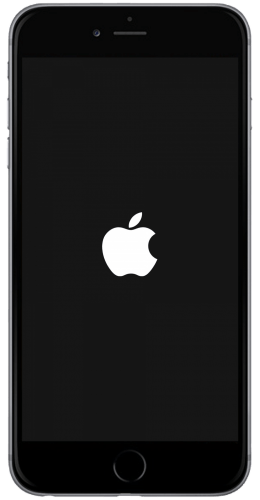
If Your iPhone Camera Isn't Working
The iPhone camera might stop working completely if liquid comes in contact with the camera. Even if the camera is working, it's very common for a water-damaged iPhone to take blurry photos. That happens when the lens becomes obstructed by water or the residue left behind when it evaporates.
There's a chance that if you leave your iPhone alone for a little while, the camera may be completely functional again. If your pictures are still blurry after a few days, you might have to repair your camera.
If Your iPhone Has No Power Or It Isn't Turning On
Water damage is often the cause of serious hardware problems that prevent your iPhone from turning on and working at all.
Liquid damage can interfere with the power supply of your iPhone or your iPhone battery's internal connection to the logic board. The Lightning port on the bottom of your iPhone is also very susceptible to water damage. Without access to power, your iPhone won't charge, and it won't turn on.
"This happened to my iPhone 4. I dropped it in a shallow swimming pool for about 15 seconds, and it never turned on again. I had to use a flip phone for the rest of that summer."
— David Lynch
Fortunately, newer iPhones are water-resistant, so this problem happens a lot less than it used to.
If you're sure you charged your iPhone, but it still has no power, try doing a hard reset. Your iPhone's software may have crashed, making the display appear completely black.
If There Are Lines On The Screen
Water damage can also make vertical lines appear on the display of your iPhone. Vertical lines on an iPhone screen usually indicates that its screen has become a little loose and the LCD cable has become disconnected from the logic board.
Water that has seeped into your iPhone may have loosen the display, damaged the LCD cable, or damaged the logic board.
If Your iPhone Flashlight Is Stuck On
Don't be surprised if your iPhone's flashlight appears "stuck" after getting exposed to water. A simple way to try and fix this problem is to perform a hard reset, which will force your iPhone to turn off and back on. Oftentimes, this will successfully get the flashlight component of your iPhone "unstuck", assuming that there isn't any significant water damage.
If everything else is working, or if you don't want to blind your friends, a piece of black electrical tape can be an effective temporary "fix".
If Your iPhone Thinks Headphones Are Plugged In
Your iPhone may falsely read that headphones are plugged into the headphone jack or Lightning port if water has entered either of these openings. When this happens, your iPhone may get stuck in headphones mode. The presence of liquid could be tricking your iPhone to thinking that headphones are plugged in even if they aren't.
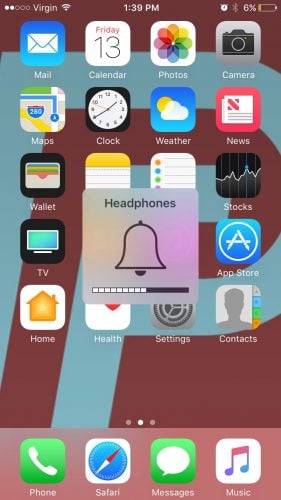
If Your iPhone Screen Is Black
Another common problem people had when they came into the Apple Store was that their iPhone screen would be black, but everything else worked normally. They could even still hear noise coming from the speakers!
When this happens, it usually means that the LCD cable got shorted out, making the screen completely black. You can try hard resetting your iPhone, but if the LCD cable is fried, it won't fix the problem.
How Does iPhone Water Damage Occur?
Water-resistant iPhones are still very susceptible to liquid damage — there's just a protective barrier that's supposed to keep water out. That barrier and its ability to resist liquids can degrade over time, making the iPhone less protected from liquid contact.
It's also important to know that water-resistant iPhones aren't designed to resist other liquids such as soaps and lotions. This is the main reason why we don't recommend bringing your iPhone with you into the bathroom when you take a shower or bath.
Below, we'll talk about several different types of liquid damage and some scenarios that can result in iPhone water damage.
Water Damage From Steam
Believe it or not, your iPhone can get water damage from steam, which we hear has some relation to water. (A joke.) Apple recommends not using your iPhone in places like a sauna or any environment with extremely humid conditions.
Steam can creep its way into openings of your iPhone and condensate once it gets inside. When the steam condenses, water can spread all throughout the inside of your iPhone.
Can Rain Cause iPhone Water Damage?
Yes, rain, another form of water, can cause iPhone water damage. Although every iPhone since the iPhone 7 is water- and splash-resistant, even the slightest amount of liquid can cause water damage. Unless your iPhone is in perfect condition, we recommend that you avoid using your iPhone in rainy weather. Rainwater can enter the ports and cause a lot of damage.
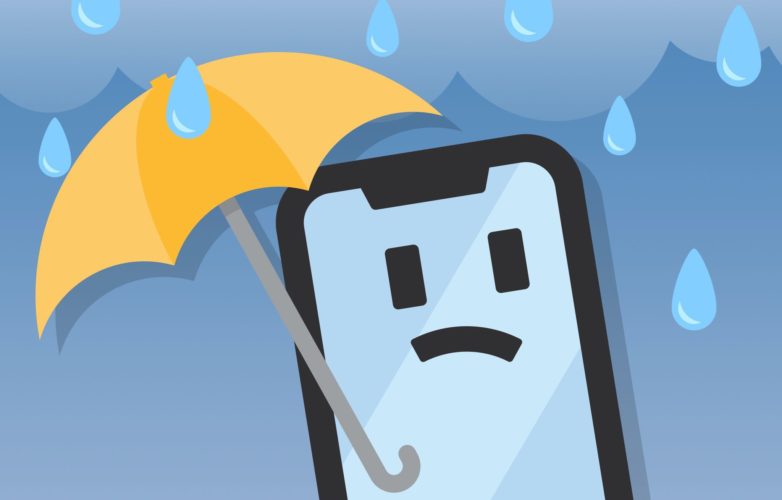
You also need to be careful about using wired headphones on a rainy day, especially if you have an older iPhone. Water can run down the wires of your headphones into the headphone jack or Lightning port of your iPhone and cause damage once inside.
Water Damage From Gym Sweat
Your iPhone is at risk of water damage if you use wired headphones at the gym. If you use wired headphones, sweat can run down the wire and enter the headphone jack or charging port. To avoid this problem completely, pick up a pair of Bluetooth headphones. No wires, no problem!
Can Salt Water Damage Your iPhone?
Newer iPhones are water-resistant, but they're not saltwater-resistant. Salt water poses and additional threat that regular water doesn't — corrosion.
Salt water can corrode the internal components of your device, which adds another obstacle on top of potential water damage. It's incredibly difficult to clean or fix corroded parts of an iPhone. You may have to get the corroded components replaced, or replace your entire phone.
How Quickly Can Water Damage Occur?
You'd be surprised by how much water can get inside of an iPhone, even after just a moment of submersion. Customers at the Genius Bar frequently had no idea why their iPhone suddenly stopped working — or so they said. Imagine their shock when I showed them the pool of water inside their iPhone after I opened it up!
But I Thought My iPhone Was Waterproof!
Advertising phones as water-resistant is a wonderfully effective tactic, because it makes people believe that they're actually waterproof. But they're not.
The water-resistance of iPhones are rated by Ingress Progression, which is called an IP rating. This rating tells customers exactly how water and dust-resistant their phone is, with different specifications for each rating.
iPhones before the 6s are not rated. The iPhone 7, 8, X, XR, and SE 2 are IP67. This means that these phones are dust-resistant and water-resistant when submerged up to 1 meter in water or less.
Every new iPhone since the iPhone XS (excluding the iPhone SE 2) are rated IP68. Some are designed to be water-resistant when submerged no deeper than 2 meters for up to 30 minutes. Others, like the iPhone 12 Pro, can resist water when submerged up to six meters!
Apple also states that IP68 iPhones can withstand spills from common household drinks like beer, coffee, juice, soda, and tea.
Once again, Apple doesn't cover liquid damage for iPhones, so we do not recommend intentionally testing these standards on your own!
| Model | IP Rating | Dust Resistance | Water Resistance |
|---|---|---|---|
| iPhone 6s & earlier | Not rated | N/A | N/A |
| iPhone 7 | IP67 | Complete protection | Up to 1 meter deep for 30 minutes |
| iPhone 8 | IP67 | Complete protection | Up to 1 meter deep for 30 minutes |
| iPhone X | IP67 | Complete protection | Up to 1 meter deep for 30 minutes |
| iPhone XR | IP67 | Complete protection | Up to 1 meter deep for 30 minutes |
| iPhone SE 2 | IP67 | Complete protection | Up to 1 meter deep for 30 minutes |
| iPhone XS | IP68 | Complete protection | Up to 2 meters deep for 30 minutes |
| iPhone XS Max | IP68 | Complete protection | Up to 2 meters deep for 30 minutes |
| iPhone 11 | IP68 | Complete protection | Up to 2 meters deep for 30 minutes |
| iPhone 11 Pro | IP68 | Complete protection | Up to 4 meters deep for 30 minutes |
| iPhone 11 Pro Max | IP68 | Complete protection | Up to 4 meters deep for 30 minutes |
| iPhone 12 | IP68 | Complete protection | Up to 6 meters deep for 30 minutes |
| iPhone 12 Mini | IP68 | Complete protection | Up to 6 meters deep for 30 minutes |
| iPhone 12 Pro | IP68 | Complete protection | Up to 6 meters deep for 30 minutes |
| iPhone 12 Pro Max | IP68 | Complete protection | Up to 6 meters deep for 30 minutes |
Emergency! I Just Dropped My iPhone In Water. What Should I Do?
When your iPhone comes into contact with water or another liquid, acting quickly and correctly can be the difference between a broken phone and one that works. Above all, don't panic.
It doesn't matter how fast you act, however, if you don't know what to do. Some of the most popular water damage "fixes" actually do more harm than good. If you think your iPhone is water damaged, set it down on a flat surface and follow the steps below.
Before we begin, we'd like to caution you against one thing: Don't tilt or shake your iPhone, because that can cause the water inside your iPhone to spill onto other components and cause more damage.
What To Do When Your iPhone Gets Water-Damaged
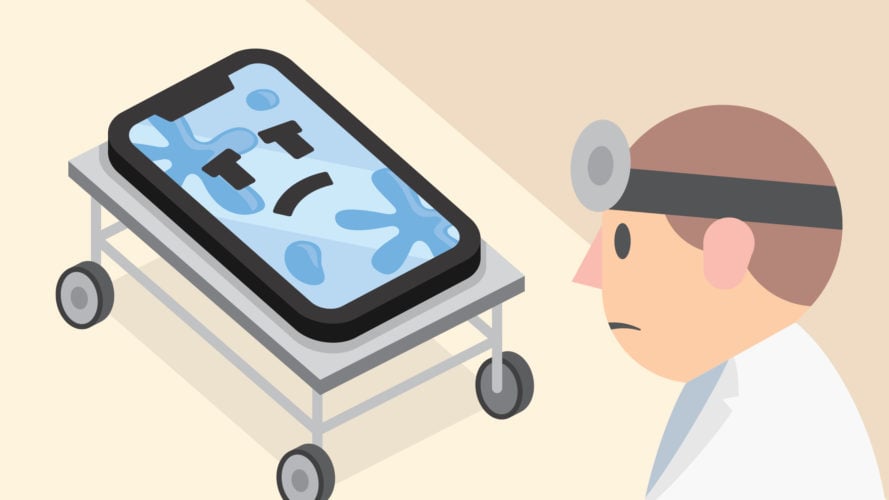
1. Remove The Liquid From The Outside Of Your iPhone
If your iPhone is in a case, remove it while holding your iPhone horizontally, with the screen pointing at the floor. Imagine there's a pool of liquid inside (because there very well may be) and you don't want that pool to migrate in any direction.
Next, use a microfiber or other soft, absorbent cloth to wipe away any water on the outside of your iPhone. Don't use a tissue, cotton swab, or anything else that can break apart or leave dust or residue inside your iPhone.
2. Remove The SIM Card
One of the first things you'll want to do when your iPhone has been exposed to water is to remove its SIM card. This serves the dual purpose of helping to save the SIM card itself and allowing air to enter your iPhone.
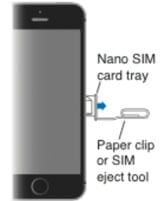
Unlike the old days, an iPhone's SIM card doesn't contain your contacts or personal information. It's only purpose is to connect your iPhone to the cellular network. Fortunately, SIM cards usually survive spills, unless they're exposed to liquid for an extended period of time.
If you have a fan, you can try blowing cool air directly into the lightning port or SIM card slot to increase airflow. Leave plenty of space between the fan and your iPhone. A gentle breeze is more than enough to help the evaporation process. Don't use a blow dryer or any other kind of fan that blows hot air.
3. Lay Your iPhone On A Flat Surface In A Dry Location
Next, lay your iPhone face down on a flat surface, like a kitchen counter or a table. Choose a location with low humidity. Don't place your iPhone in a container or a bag.
Tilting your iPhone or placing it in a bag with rice will almost certainly cause the water to spill onto other internal components. That could be the difference between life and death for your iPhone.
4. Set Desiccants On Top Of Your iPhone
If you have access to commercial desiccants, set them on top of and around your iPhone. Whatever you do, don't use rice! (More about that later.) It's not an effective desiccant.
What Are Desiccants?
Desiccants are substances that produce a state of dryness in other objects. They can be found in tiny little packets that are shipped with items such as vitamins, electronics, and clothes. Next time you get a package, save them! They'll come in handy when you're dealing with a liquid damage emergency.
5. Wait For The Water To Evaporate
Once you've taken the initial steps to triage your iPhone, putting it down and walking away for is often the best thing you can do. If there is water inside your iPhone, the water's surface tension will help to prevent it from spreading. Moving your iPhone can only cause more problems.
As we'll mention later, scientific studies have shown that exposing water-damaged electronics to open air can be more effective than sticking it in rice. By taking out the SIM card, we've allowed more air to get inside your iPhone, and that helps the evaporation process.
We recommend waiting 24 hours before trying to turn your iPhone back on. Apple says to wait at least five hours. The more time, the better. We want to give any water inside your iPhone enough time to begin to evaporate.
6. Try Turning Your iPhone Back On
While your iPhone is still on a flat surface, plug it into power and wait for it to turn on. You can try using the power button, but you might not need to. If you've waited the 24 hours we've suggested, chances are it will have run out of battery. When that happens, your iPhone should turn on automatically after a few minutes of charging.
7. Back Up Your iPhone, If You Can
If your iPhone turns on, back it up right away using iCloud or iTunes. Water damage can sometimes spread, and you may only have a small window of opportunity to save your photos and other personal data.
8. Additional Steps, Depending On The Situation
Depending on where you drop your iPhone, there can be other issues that require attention. Let's take a case-by-case look at three common scenarios:
I Dropped My iPhone In The Toilet!
Dropping your iPhone in a toilet adds another factor to the situation: bacteria. In addition to following the steps above, we suggest wearing latex gloves while you handle your iPhone. Remember to disinfect your hands afterwards too!
When I was at Apple, I remember one situation where someone handed me a phone, smiled, and said, "I dropped it in the toilet!"
I replied, "You didn't think to tell me this before you handed me your phone?" (This was not the correct thing to say in a customer service situation.)
"I wiped it off!" she said unapologetically.
If you bring your iPhone into an Apple Store or local repair shop after dropping it in the toilet, please be sure to tell the technician that it's a "toilet phone" before you hand it to them. I'd suggest putting it in a ziplock bag for transport.
— David Payette
I Dropped My iPhone In The Sink!
If you dropped your iPhone in the sink, soap and food scraps can cause additional problems for your iPhone. Even if your iPhone is water-resistant, it isn't soap-resistant.
Apple recommends rinsing your iPhone off with tap water if it's exposed to any other liquid.
Your iPhone also isn't food-resistant. Any scraps of food in your sink could potentially get lodged into the ports of your iPhone. If you see any scraps of food inside your iPhone's ports, scrape them out using an anti-static brush or brand new toothbrush.
I Dropped My iPhone In The Bathtub!
Just like dropping your iPhone in the sink, dropping it in the bathtub can bring in problems with soaps, shampoos, and other shower products. Rinse off any areas of your iPhone that were exposed to shower products using tap water.
To Sum Up
If your iPhone is water damaged, lay your iPhone with the display facing down on a flat surface in a dry location. Remove the SIM card. Hold it horizontally, and don't tilt or shake it. If you have commercial desiccants, place them on top of your iPhone. Don't use rice, because scientific studies have shown that air is just as good, if not better. Wait 24 hours and let the water evaporate on its own before you try to turn it back on.
What You Shouldn't Do: Water Damage Myths
There are a lot of at-home quick fixes and "miracle cures" others may recommend. However, we strongly recommend not listening to myths about miracles cures.
A lot of the time, those "cures" can do more harm than good to your iPhone. In some cases, the at-home fixes can cause irreversible damage to your iPhone.
Myth 1: Put Your iPhone In A Bag Of Rice
The first myth we want to debunk is the most common "fix" for water-damaged iPhones: "If your iPhone gets wet, stick it in a bag of rice." There's a lot of conjecture about this issue, so we looked for a scientific basis for saying that rice doesn't work.
We found one scientific study called "The effectiveness of commercial desiccants and uncooked rice in removing moisture from hearing aids" that sheds light on the subject. Obviously, a hearing aid is different than an iPhone, but the question it addresses is the same: What's the best way to remove liquid from small, water-damaged electronics?
The study found that there's no advantage to putting hearing aids in white or brown rice instead of just laying it down on an empty table and letting it air dry. However, there are definite disadvantages to using rice to attempt to dry out your iPhone.
Rice can sometimes ruin an iPhone that otherwise could have been salvaged. A piece of rice can easily get wedged in a headphone jack or a charging port.
The Lightning port is just about the size of a single grain of rice. Once one gets stuck inside, it can be very difficult, and sometimes impossible to remove.
And so we want to be clear: Do not put your iPhone in a bag of rice. White rice; brown rice; it doesn't matter. Plus, when you put your iPhone in bag of rice, you've wasted perfectly good rice!
Myth 2: Put Your iPhone In The Freezer
The second myth we'd like to address is whether or not it's a good idea to put your water-damaged iPhone in the freezer. We believe people try putting their iPhone in the freezer to prevent the water from spreading all over the place. However, as soon as you take your iPhone out of the freezer, the water will just melt and spread throughout your iPhone anyway.
When dealing with iPhone water damage, we want to get the water out as soon as possible. Putting your iPhone in the freezer does the opposite of this. It freezes the water inside your iPhone, trapping it and preventing it from escaping.
Water is one of the only liquids that expands as approaches freezing. This means that freezing your iPhone will increase the volume of the water trapped inside, and possibly bring it into contact with previously undamaged components.
There's yet another reason why you probably shouldn't put your iPhone in the freezer. iPhones have a standard operating temperature between 32–95° F. Their non-operating temperature only goes as low as -4° F, so it would be unsafe to put on in an environment colder than that.
The standard freezer operates at 0° F, but they can sometimes be made colder. If you put your iPhone in a freezer at -5° F or colder, you run the risk of causing additional damage to your iPhone.
Myth 3: Blow Dry Your iPhone, Or Stick It In The Oven! It Drys Your Hair, Shouldn't It Dry Your iPhone?
Do not attempt to blow dry the water out of your iPhone. Using a blow dryer could actually make the problem worse!
A blow dryer will push water deeper into your iPhone. This would expose more of your iPhone to water, which is the opposite of what we want to happen.
If you're thinking of placing your iPhone in an oven to try to evaporate the water with heat, we wouldn't recommend that either. According to Apple's specifications, the iPhone XS has an operating temperature of up to 95° F (35° C) and a non-operating temperature of up to 113° F (45° C).
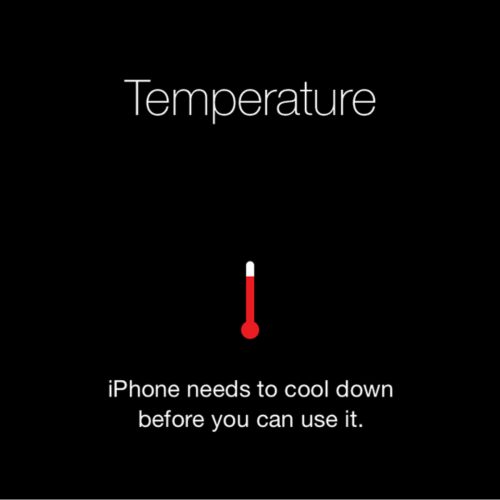
If you have an oven that heats up to 110° F, then give it a try! I checked, and unfortunately, the lowest temperature on mine is 170° F.
Although some of the water-sensitive electronics inside your iPhone could theoretically withstand much higher temperatures, the screen, battery, waterproof seal, and other components are not as heat-resistant.
Myth 4: Use Isopropyl Alcohol To Dry Your iPhone
Isopropyl alcohol is a less-commonly used home solution for fixing iPhone water damage. There are three big concerns when putting your iPhone in isopropyl alcohol.
First, alcohol can wear down the oleophobic coating on your iPhone's display. The oleophobic coating is what makes your the display fingerprint-resistant. You run the risk of really degrading the quality of the display by putting your iPhone in alcohol.
Second, isopropyl alcohol is always diluted with some amount of another liquid. Usually, it's water. By exposing your iPhone to isopropyl alcohol, you're also exposing it to even more liquid.
Third, isopropyl alcohol is a polar solvent. This means it's extremely conductive. One of the biggest problems with water damage is that it creates electric charges in places where it's not supposed to.
You'd have to disconnect everything from your iPhone's battery before you could even begin to consider using isopropyl alcohol. Disassembling an iPhone is a challenging task, requires a specialized toolkit, and can completely void your warranty.
For these reasons, we strongly advise against try to fix your water-damaged iPhone using isopropyl alcohol.
If you've taken the steps above and you're still having issues, it's time to make a decision about how to proceed. There are a lot of options, from buying a new phone to repairing a single component. Our goal is to provide you with the information you need to make the best decision for you and your water-damaged iPhone.
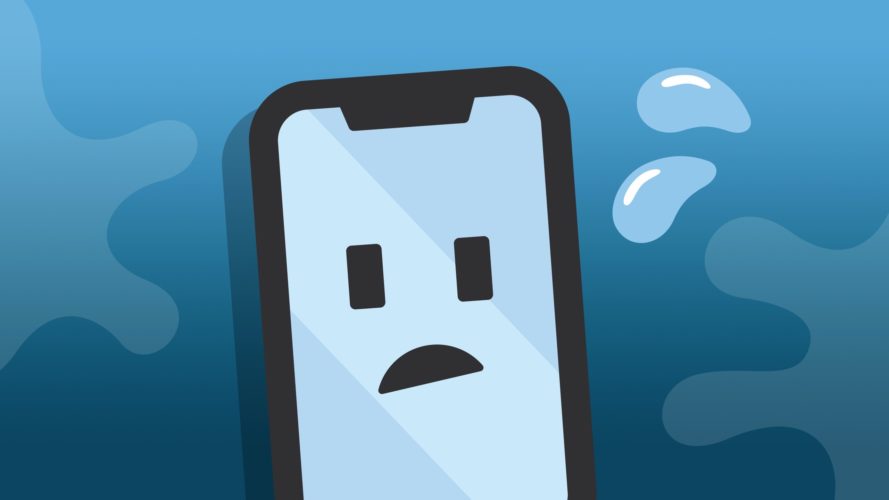
Can iPhone Water Damage Be Fixed?
Sometimes it can, and sometimes it can't. Water damage is unpredictable. You'll increase your chances of rescuing your iPhone by following our the steps we recommend above, but there are no guarantees.
Remember that the effects of water damage aren't always immediate. As liquid migrates inside an iPhone, components that had been working may suddenly stop. It could be days or weeks until problems start to occur.
First Consideration: Do You Have AppleCare+ Or Insurance?
If you have AppleCare+ or insurance through your wireless carrier, start there. AT&T, Sprint, Verizon, T-Mobile, and other carriers all offer some form of insurance. You'll have to pay a deductible, but it usually costs a lot less than the price of a new iPhone.
However, If you have an older phone and you're looking for a reason to upgrade, then this may be the perfect time. The deductible for some carriers is actually a lot more out-of-pocket than financing a new iPhone with a monthly payment.
About AppleCare+
AppleCare+ covers up to two "incidents" of liquid or other accidental damage, with a $99 service fee. If you don't have AppleCare+, an out-of-warranty repair for water damage can be very expensive.
Apple doesn't repair individual components on water-damaged iPhones — they replace the entire phone. Although this may seem like a rip-off, their reason for doing so makes sense.
Even though an individual part can sometimes be repaired, water damage is tricky and can often cause problems down the road as the water spreads throughout your iPhone.
From Apple's perspective, it wouldn't be possible to offer a warranty on an iPhone that could break without warning. You'll still pay less to replace an iPhone through AppleCare+ if you pay the deductible.
That said, and especially given the out-of-warranty price of a repair through Apple, third-party services or repair shops that repair individual parts may be your best bet. Just know that replacing any component on your iPhone with a non-Apple part will completely void your warranty.
Apple Water Damage Repair Pricing
| Model | Out-Of-Warranty | With AppleCare+ |
|---|---|---|
| iPhone 12 Pro Max | $599.00 | $99.00 |
| iPhone 12 Pro | $549.00 | $99.00 |
| iPhone 12 | $449.00 | $99.00 |
| iPhone 12 Mini | $399.00 | $99.00 |
| iPhone 11 Pro Max | $599.00 | $99.00 |
| iPhone 11 Pro | $549.00 | $99.00 |
| iPhone 11 | $399.00 | $99.00 |
| iPhone XS Max | $599.00 | $99.00 |
| iPhone XS | $549.00 | $99.00 |
| iPhone XR | $399.00 | $99.00 |
| iPhone SE 2 | $269.00 | $99.00 |
| iPhone X | $549.00 | $99.00 |
| iPhone 8 Plus | $399.00 | $99.00 |
| iPhone 8 | $349.00 | $99.00 |
| iPhone 7 Plus | $349.00 | $99.00 |
| iPhone 7 | $319.00 | $99.00 |
| iPhone 6s Plus | $329.00 | $99.00 |
| iPhone 6s | $299.00 | $99.00 |
| iPhone 6 Plus | $329.00 | $99.00 |
| iPhone 6 | $299.00 | $99.00 |
| iPhone SE | $269.00 | $99.00 |
| iPhone 5, 5s, and 5c | $269.00 | $99.00 |
| iPhone 4s | $199.00 | $99.00 |
| iPhone 4 | $149.00 | $99.00 |
| iPhone 3G and 3GS | $149.00 | $99.00 |
About Carrier Insurance
AT&T, Sprint, T-Mobile, and Verizon use a company called Asurion to provide phone insurance to customers. Asurion Phone Insurance Plans cover liquid damage. After filing a claim, Asurion typically replaces the damaged device within 24 hours, as long as it's covered under warranty.
Here are some helpful links if you do have carrier insurance and would like to file a claim for water damage:
| Carrier | File A Claim | Pricing Information |
|---|---|---|
| AT&T | File An Insurance Claim | |
| T-Mobile | File An Insurance Claim | – Protection<360> Phone Replacement Pricing – Basic Device Protection Phone Replacement Pricing – Premium Handset Protection (Prepaid) Phone Replacement Pricing |
| Verizon | File A Claim | Phone Replacement Pricing |
Should I Repair My iPhone Or Buy A New One?
When you compare the cost of a new phone to the cost of replacing a single part, sometimes replacing the single part is the way to go. But sometimes it isn't.
If the rest of your iPhone is in good shape and your phone is relatively new, then a repair may be your best bet, especially if the water-damaged part is a speaker or another relatively inexpensive part.
Replacing the entire iPhone may be the right move if more than one component is broken or it won't turn on at all. It'll be less of a headache and may be cheaper than replacing multiple broken parts.
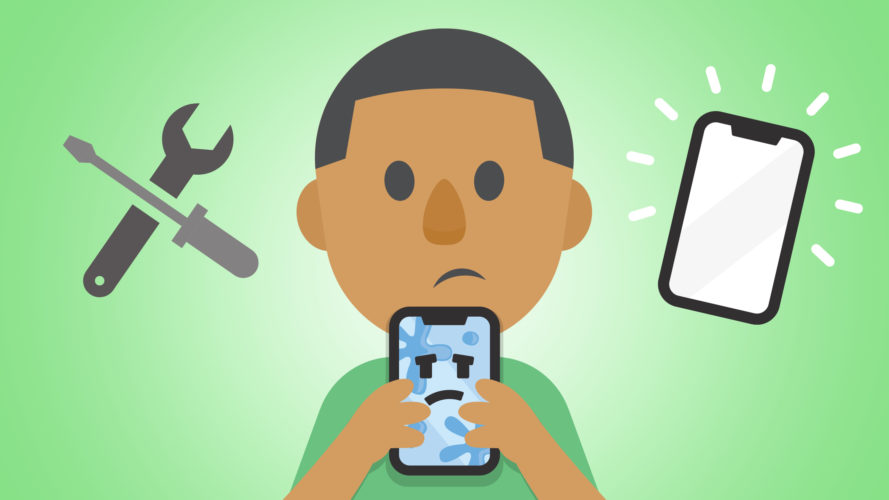
Whenever you buy a new phone, you have a big opportunity to save money. Up until recently, a lot of people stayed with their current carrier by default, because comparing prices across carriers was tedious and time-consuming.
We created UpPhone to solve that problem. Our website has a search engine that makes it easy to compare every cell phone and every cell phone plan in the United States, side-by-side.
Even if you're happy with your current carrier, it might be worth taking a quick look at the newest plans they offer. Prices have dropped as competition has increased, and carriers don't always let their current customers know when they could be saving money.
iPhone Water Damage Repair Options
On-Demand Repair Services
On-demand, "we come to you" third-party repair companies are a great option if you just dropped your iPhone in water. Many of these repair services can send someone to you in less than an hour.
Puls is one of our favorite on-demand repair services. They can send a certified technician directly to your door in as little as sixty minutes, and offer a lifetime warranty on all services.

Local Repair Shops
Your local "mom and pop" iPhone repair shop is another way to get immediate help if you drop your iPhone in water. Odds are that it won't be as busy as an Apple Store, and usually you don't have to make an appointment.
However, we do recommend giving them a call before you go into the store. Not every repair shop repairs water-damaged iPhones, and sometimes local shops don't have individual parts in stock. If your local repair shop recommends repairing multiple parts of your iPhone, you may want to consider purchasing a new phone.
Mail-In Repair Services
You may want to avoid mail-in services if you think your iPhone has water damage. Shipping your iPhone can shake it around and increase the risk of water spreading throughout your iPhone.
However, if your iPhone is dry and it isn't coming back to life, mail-in repair services often have turnaround times of just a few days and can cost less than other options.
Can I Fix A Water-Damaged iPhone Myself?
We don't recommend trying to repair a water-damaged iPhone on your own, especially if you've never done it before. It can difficult to know what parts of your iPhone actually need to be replaced. It can be even harder to find high-quality replacement parts.
Disassembling your iPhone requires a special set of tools. If you're the adventurous type, you can buy an iPhone repair kit on Amazon for less than $10.
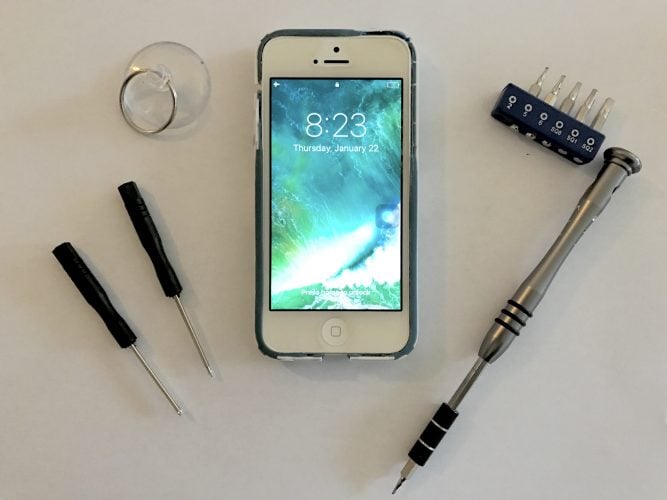
Can I Sell A Water-Damaged iPhone?
Some companies will purchase water-damaged iPhones from you in order to recycle them safely or salvage the parts that are still working. You probably won't get much, but it's better than nothing, and that money can be put towards purchasing a new phone.
Check out our article for a comparison of the places where you can sell your iPhone.
To Sum Up About Your Repair Options
As we said before, sometimes the best option is to upgrade to a new iPhone, especially if your current phone would cost a lot to repair. Every iPhone since the iPhone 7, and many newer Androids, like the Google Pixel 3 and Samsung Galaxy S9, are water-resistant.
The choice, however, is entirely up to you. Start by investigating your insurance coverage, and then move onto pricing out repairs. We know you'll make the right decision.
Conclusion
iPhone water damage problems are frustrating and difficult to solve, and we really hope this article helped you to fix your broken iPhone. We'd be grateful if you'd share this article with your friends, so they know what to do when they drop their phone in the toilet.
We'd love to hear about your experience with iPhone liquid damage in the comments section below. Have you tried any other at-home liquid damage fixes? If you decided to get a new phone, which one did you pick? If you have any questions, feel free to ask them there, and we'll to our best to get back to you.
How To Repair Water Damaged Iphone
Source: https://www.payetteforward.com/iphone-water-damage-ultimate-guide-how-to-fix-liquid-damage/
Posted by: williamsgrothe1954.blogspot.com

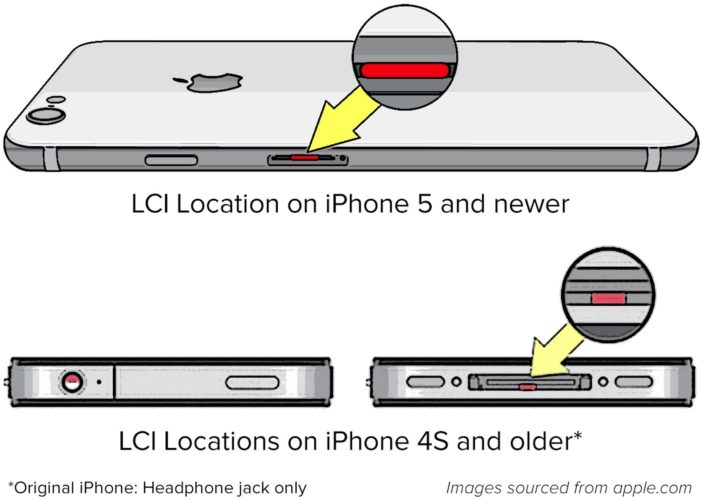
0 Response to "How To Repair Water Damaged Iphone"
Post a Comment